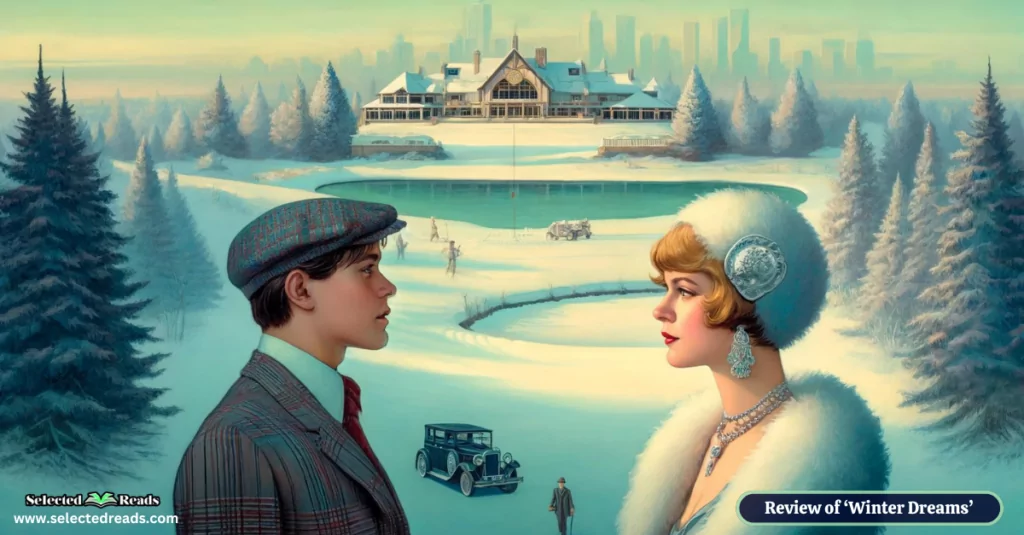Today, we delve into “Winter Dreams” by F. Scott Fitzgerald, a poignant short story that is often considered one of his best works. Initially published in 1922, this narrative falls within the realm of American literary realism, capturing the essence of the Jazz Age’s disillusionment and the complexities of social mobility and romantic idealism.
The aim of this post is to guide you through the significant elements of “Winter Dreams,” offering insights into its plot and characters without diminishing the pleasure of discovering its intricacies firsthand. Our discussion will unfold by first summarizing the story, followed by an analysis of its key characters. To enhance our exploration, I’ll conclude with several stimulating questions intended for book club discussions or personal contemplation.
Winter Dreams Summary
“Winter Dreams” by F. Scott Fitzgerald tells the story of Dexter Green, a young man from a modest background who aspires to be a part of the affluent world. The narrative begins with Dexter working as a caddy at a prestigious golf club in Minnesota, a job he quits after an encounter with Judy Jones, a beautiful and capricious young woman from a wealthy family. Dexter is mesmerized by her beauty and her world, which symbolizes the wealth and status he yearns to achieve.
As Dexter grows older, he attends an elite university and starts a successful laundry business, making a considerable fortune that allows him to mingle with the upper class. Despite his success, Dexter’s infatuation with Judy remains a constant in his life. Over the years, they cross paths several times, and each encounter with Judy rekindles his “winter dreams,” a metaphor for his youthful hopes and ambitions for love and success.
Photo: Amazon
Judy and Dexter’s relationship is turbulent and unfulfilling. Judy is depicted as emotionally manipulative and fickle, having numerous affairs and engagements that she breaks off on a whim. Despite her treatment of him, Dexter remains devoted to her, his dreams tethered to the idea of possessing both her and the lifestyle she represents.
The story shifts towards a somber tone as Dexter’s dreams begin to unravel. After serving in World War I, Dexter returns to find that Judy has married a man who mistreats her. Learning of Judy’s faded beauty and unhappy marriage, Dexter is devastated, not just by the loss of Judy but by the realization that his dreams have been built on a fleeting and superficial desire. He understands that the illusions of his youth are gone, replaced by the harsh realities of life.
“Winter Dreams” ends with Dexter reflecting on the loss of his youthful aspirations and the emptiness of his current existence. He mourns not only for Judy but for the death of his dreams, which were as ephemeral as the seasons. Through Dexter, Fitzgerald explores themes of social ambition, love, and disillusionment, foreshadowing the more expansive treatment of similar themes in his later work, “The Great Gatsby.”
Related: The Overstory Summary, Characters, and Book Club Questions
Winter Dreams Characters
In “Winter Dreams” by F. Scott Fitzgerald, the primary characters include:
- Dexter Green: The protagonist of the story, Dexter is a young man from a modest background who is determined to rise above his humble beginnings. Ambitious and driven, he seeks wealth and social status, partly through his infatuation with Judy Jones. Dexter’s journey from a hopeful youth to a disillusioned adult serves as the central narrative arc of the story.
- Judy Jones: The object of Dexter’s affection and a symbol of the luxurious life he desires, Judy is depicted as strikingly beautiful, charming, and capricious. Her relationships are shallow and fleeting, reflecting her manipulative and fickle nature. Judy profoundly influences Dexter’s life and dreams, ultimately embodying the unattainable and transient nature of those dreams.
- Mr. Mortimer Jones: Judy’s father, who is wealthy and a member of the elite golf club where Dexter first caddies. He represents the affluent society that Dexter aspires to join.
- Devlin: A business acquaintance of Dexter’s who provides him with the distressing news about Judy’s later life. His role in the story brings about the final revelation that shatters Dexter’s illusions about Judy and his own aspirations.
- Irene Scheerer: A young woman Dexter becomes engaged to during a period when he attempts to move beyond his infatuation with Judy. Irene represents the stability and wholesomeness that Judy does not, but Dexter ultimately breaks off the engagement when Judy reenters his life, drawn back by his persistent dreams.
Winter Dreams Book Club Questions
For your book club discussion on F. Scott Fitzgerald’s “Winter Dreams,” here are some engaging questions to explore the themes, characters, and narrative style of the story:
- Character Analysis: How does Dexter Green’s background influence his aspirations and interactions with other characters? Discuss the transformation of Dexter’s character from the beginning to the end of the story.
- Themes of Ambition and Disillusionment: In what ways do Dexter’s ‘winter dreams’ symbolize his ambitions? How does Fitzgerald use the metaphor of seasons to reflect changes in Dexter’s life and his ultimate disillusionment?
- Role of Judy Jones: Judy Jones is a complex character whose beauty and allure drive much of Dexter’s actions. Discuss how Judy is portrayed in the story. Is she a fully fleshed-out character, or does she serve more as a symbol within Dexter’s dreams?
- Social Class and Aspirations: How does Fitzgerald critique the American Dream through Dexter’s pursuit of wealth and social status? Discuss how social class impacts the characters’ lives and decisions.
- Comparisons to “The Great Gatsby”: Fitzgerald later expanded on many themes from “Winter Dreams” in “The Great Gatsby.” What similarities do you find between Dexter Green and Jay Gatsby? How do both characters relate to their respective love interests?
- Narrative Style: How does Fitzgerald’s narrative style enhance the themes of the story? Consider his use of imagery, symbolism, and tone throughout the text.
- Impact of Settings: Discuss the significance of the settings in the story, from the Sherry Island Golf Club to the cities where Dexter conducts his business. How do these settings contribute to the development of the story’s themes?
- The Concept of Time: How does Fitzgerald handle the passage of time in “Winter Dreams”? What effect does this have on your understanding of Dexter’s life and changes?
- The Ending: Dexter’s reaction to the news about Judy at the end of the story is quite profound. What do you think Fitzgerald is saying about the nature of idealism and reality? How does this conclusion resonate with you?
- Personal Reflections: Have you ever experienced a disillusionment similar to Dexter’s in pursuit of a dream? How did you relate personally to the themes of the story?
Related: Interpreter of Maladies Summary and Book Club Questions
Final thoughts
To wrap up, I trust this overview has piqued your interest in “Winter Dreams” by F. Scott Fitzgerald. This narrative is a masterful depiction of ambition, love, and the inevitable disenchantment that often accompanies the pursuit of an idealized life. If you haven’t yet experienced this classic, I strongly recommend diving into its pages to explore Fitzgerald’s elegant prose and the timeless themes that resonate as much today as they did nearly a century ago.









